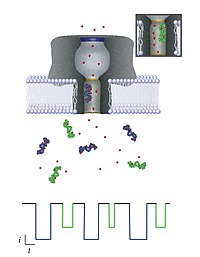
Photo from wikipedia
Nanopores are valuable single-molecule sensing tools that have been widely applied to the detection of DNA, RNA, proteins, viruses, glycans, etc. The prominent sensing platform is helping to improve our… Click to show full abstract
Nanopores are valuable single-molecule sensing tools that have been widely applied to the detection of DNA, RNA, proteins, viruses, glycans, etc. The prominent sensing platform is helping to improve our health-related quality of life and accelerate the rapid realization of precision medicine. Solid-state nanopores have made rapid progress in the past decades due to their flexible size, structure and compatibility with semiconductor fabrication processes. With the development of semiconductor fabrication techniques, materials science and surface chemistry, nanopore preparation and modification technologies have made great breakthroughs. To date, various solid-state nanopore materials, processing technologies, and modification methods are available to us. In the review, we outline the recent advances in nanopores fabrication and analyze the virtues and limitations of various membrane materials and nanopores drilling techniques.
Journal Title: Nanotechnology
Year Published: 2022
Link to full text (if available)
Share on Social Media: Sign Up to like & get
recommendations!